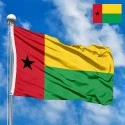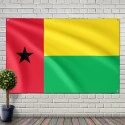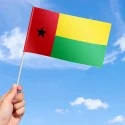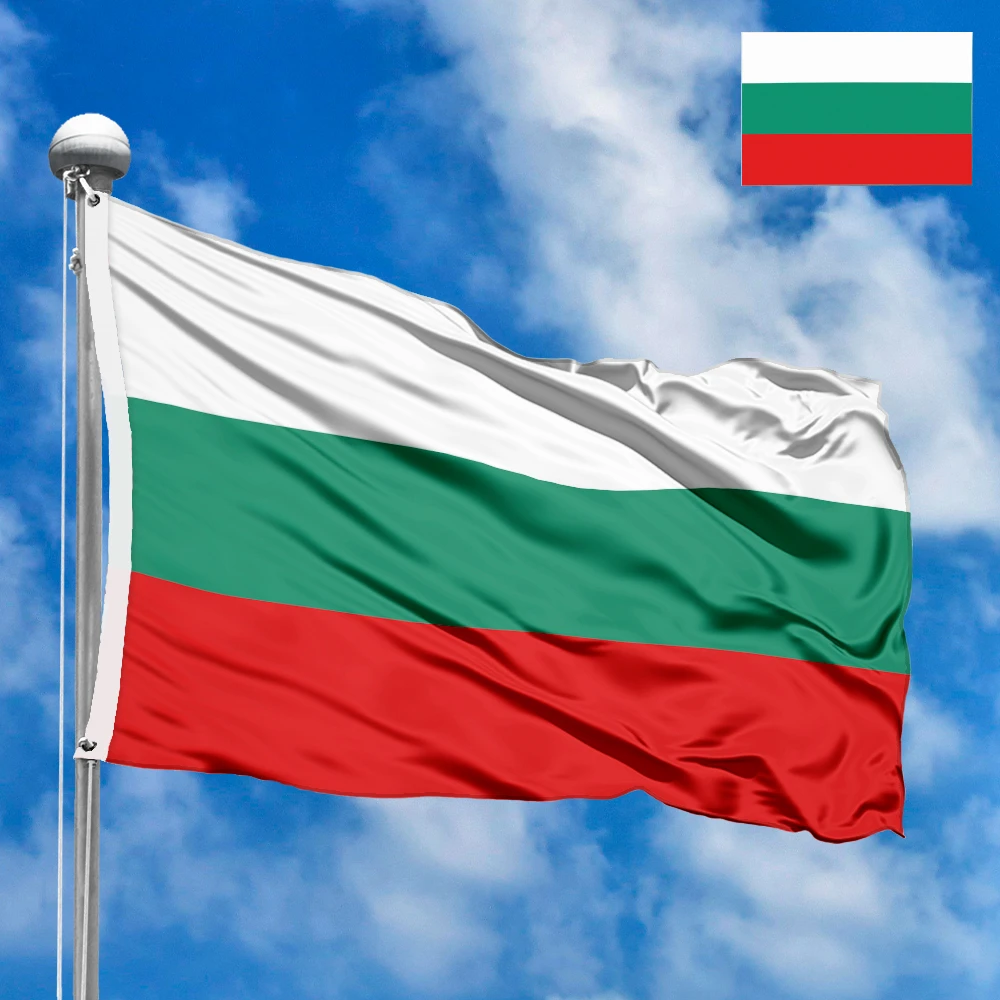Flag of Guinea-Bissau
- Flag Type: State
- Proportions (official): 1:2
- Official name: Republic of Guinea-Bissau
- Local name: República da Guiné-Bissau
- Sovereignty (year): YES (1974)
- Member of Organizations: UN, African Union, Organization of Islamic Cooperation
- Country code, territory: GW, GNB, 624
- Capital: Bissau
- Large cities: Bafatá, Gabú, Cacheu
- Population: ~2,200,000 (2024, UN)
- Religions: Islam ~45%, Christianity ~22%, Traditional beliefs ~31%
- Area (km²): 36 125
- Highest point: Monte Torin (262 m)
- Lowest point: Atlantic Ocean (0 m)
- Currency: West African CFA franc (XOF, CFA)
- Languages: Portuguese, Crioulo
- Dialing code: +245
- National domain: .gw
Flag Information
General information
Demography and Culture
Economy and communications
- All Flags
- Flags of Countries by Continent
-
Flags of Organizations
- Flags of UN countries
- Flags of the European Union countries
- Flags of NATO countries
- Flags of the countries of the Organization of Islamic Cooperation
- Flags of the countries of the Organization of American States
- Flags of the Arab League countries
- Flags of the African Union countries
- Flags of the countries of the Union of South American Nations
- Flags of the Commonwealth of Nations
- Flags of the countries of the Secretariat of the Pacific Community
- Flags of the Nordic Council countries
- Flags of the Caribbean Community
- Flags of the countries of the Association of Southeast Asian Nations
- Flags of the East African Community
- Flags of the countries of the Organization of Turkic States
- LGBT Community Flags
- Historical Flags
- Ethnic Flags
- Flags of the USA (states)
Description
The national flag of Guinea-Bissau is a vibrant and deeply symbolic emblem that embodies the nation's struggle for independence, its revolutionary ideals, and its aspirations for a prosperous and unified future. Adopted on September 24, 1973, the day Guinea-Bissau declared its independence from Portugal, the flag is a powerful visual narrative of a country that fought valiantly to free itself from colonial rule and embrace a new path guided by the principles of Pan-Africanism and self-determination.
Design and Symbolism: A Palette of Revolution and Hope
The flag of Guinea-Bissau features a vertical red stripe on the hoist side, containing a black five-pointed star. The remaining two-thirds of the flag are divided horizontally into two equal bands: a yellow band on top and a green band on the bottom. Each color and element on the flag is imbued with profound significance, reflecting the nation's historical journey and its core values:
-
Red Vertical Stripe (Hoist Side): The prominent vertical red stripe symbolizes the blood shed during the struggle for independence. It is a powerful tribute to the sacrifices made by the liberation fighters and martyrs who gave their lives to free Guinea-Bissau from Portuguese colonial rule. Red is universally recognized as the color of courage, valor, and revolution, and in this context, it represents the intensity and determination of the fight for self-determination. It serves as a constant reminder of the nation's hard-won freedom.
-
Black Five-Pointed Star: Positioned centrally within the red stripe is a striking black five-pointed star. This star is the quintessential symbol of African unity and dignity. It is a direct reference to Pan-Africanism, an ideology promoting the solidarity and empowerment of African peoples. The black color specifically represents the African people and their identity, while the five points traditionally signify the five geographical regions of Africa (North, South, East, West, and Central), emphasizing the unity of the continent. For Guinea-Bissau, it symbolizes the pride in its African heritage and its commitment to the broader African liberation movement. It is often referred to as the "Black Star of Africa."
-
Yellow Horizontal Band (Top): The upper horizontal yellow band represents the sun, prosperity, and the fruits of labor. Yellow is associated with the bountiful natural resources of Guinea-Bissau, particularly its agricultural potential and the hope for economic development. It also signifies the sunlight of a new day, symbolizing hope, optimism, and the bright future envisioned for the nation after gaining independence. It reflects the aspirations for a flourishing economy and a better quality of life for all citizens.
-
Green Horizontal Band (Bottom): The lower horizontal green band symbolizes the lush forests, agriculture, and the hope for a prosperous future rooted in the nation's natural environment. Green is a universal color of growth, fertility, and hope. For Guinea-Bissau, it represents the country's rich vegetation and its agricultural heritage, highlighting the importance of the land as a source of sustenance and wealth. It also embodies the hope and optimism for national development and the well-being of its people.
Together, these elements form a cohesive and evocative representation of Guinea-Bissau's identity – a nation forged through struggle, proud of its African roots, and looking forward to a future of unity, peace, and prosperity.
Dimensions and Proportions:
The official proportions of the Flag of Guinea-Bissau are a width-to-length ratio of 1:2. This ratio is characteristic of many former Portuguese colonies and contributes to the flag's elongated and distinct appearance. The vertical red stripe occupies one-third of the flag's length (from the hoist to the fly), extending across the entire height. The black five-pointed star is centrally placed within this red stripe, its size carefully chosen to be prominent but not overwhelming, maintaining balance with the other elements. The two horizontal bands of yellow and green in the remaining two-thirds of the flag are of equal height. These precise dimensions ensure the consistent and correct representation of this important national symbol.
History and Evolution: A Banner Forged in Liberation
The history of Guinea-Bissau's flag is inextricably linked to the heroic struggle of its people for independence, led by the African Party for the Independence of Guinea and Cape Verde (PAIGC). The flag was not a post-independence creation but rather a powerful symbol of the liberation movement itself, designed and used by the PAIGC even before the country achieved full sovereignty.
-
Portuguese Guinea (Pre-1973): Before its independence, the territory was known as Portuguese Guinea. During this colonial period, the official flag flown was the flag of Portugal – originally a blue and white flag, later evolving into the current red and green flag with the armillary sphere and shield. There was no distinct local flag recognized by the Portuguese authorities. The colonial administration sought to suppress any symbols of independent identity.
-
The PAIGC and the Genesis of the Flag (1960s - 1973): The African Party for the Independence of Guinea and Cape Verde (PAIGC), founded in 1956 by Amílcar Cabral, played a pivotal role in the liberation struggle. The party developed its own flag, which would later become the national flag of independent Guinea-Bissau. The design was heavily influenced by the Pan-Africanist movement and the ideas of Kwame Nkrumah, who introduced the Pan-African colors (red, yellow, green) into the Ghanaian flag.
-
The red vertical stripe and black star were directly inspired by the Ghanaian flag, signifying the revolutionary struggle and African unity. Amílcar Cabral, a fervent Pan-Africanist, ensured these symbols were central.
-
The yellow and green horizontal stripes were chosen to represent the sun and prosperity, and the nation's agricultural wealth and hope, respectively. These colors were also part of the broader Pan-African palette, resonating with the aspirations of a liberated continent.
The PAIGC used this flag extensively during its armed struggle against Portuguese rule throughout the 1960s and early 1970s. It became a powerful rallying symbol for the liberation fighters and the civilian population, representing their shared dream of freedom and self-determination.
-
-
Declaration of Independence and Adoption (1973): On September 24, 1973, the PAIGC unilaterally declared the independence of Guinea-Bissau. The flag that had served as the symbol of their struggle was immediately adopted as the national flag of the newly independent Republic. This act solidified the flag's place as a direct embodiment of the revolutionary victory and the fulfillment of the aspirations for self-rule.
It is important to note that the flag was originally intended to be the flag of a unified Guinea-Bissau and Cape Verde, as the PAIGC fought for the independence of both territories. However, after Cape Verde achieved independence in 1975, it adopted a different flag, signifying its separate nationhood. Guinea-Bissau retained the original PAIGC flag, recognizing its deep connection to their own unique liberation history.
The flag has remained unchanged since its adoption, serving as a constant and powerful reminder of the sacrifices made for independence and the enduring commitment to the ideals of unity, African identity, and national progress.
Regional Context and West African Identity:
Guinea-Bissau's flag, while unique in its specific arrangement, is deeply rooted in the vexillological traditions of West Africa and the broader Pan-African movement. Its design elements echo themes and symbols found in many other flags across the continent, particularly those of former colonies that achieved independence through armed struggle:
-
Pan-African Colors: The use of red, yellow, and green is a direct homage to the Pan-African colors, popularized by the flag of Ghana (adopted 1957) and inspired by the Ethiopian flag (one of the oldest independent nations in Africa). These colors symbolize the blood shed for liberation (red), the mineral wealth and sun (yellow), and the land and agricultural prosperity (green). This shared color scheme connects Guinea-Bissau's flag to a collective African identity and a history of liberation from colonialism.
-
Black Star: The black star is a prominent Pan-African symbol, most famously seen on the flag of Ghana. It signifies African unity, dignity, and the guiding light of freedom. Its inclusion on Guinea-Bissau's flag underscores the nation's commitment to Pan-African ideals and solidarity with other African nations.
-
Symbolism of Struggle and Hope: Like many post-colonial flags in Africa, Guinea-Bissau's flag explicitly incorporates symbols of the struggle for independence (red for blood, black star for African liberation) alongside symbols of future prosperity and hope (yellow for wealth, green for land). This narrative of past sacrifice leading to a brighter future is a common thread in African vexillography.
-
Shared History with Cape Verde (PAIGC link): The flag's origin in the PAIGC, an organization that fought for the independence of both Guinea-Bissau and Cape Verde, highlights a unique shared historical and political bond within the Lusophone African context. While Cape Verde later adopted a different flag, the common genesis of their liberation movements' flags remains a testament to this shared past.
Guinea-Bissau's flag thus fits comfortably within the rich tapestry of West African and Pan-African flags, standing as a proud emblem of its own unique journey while also signaling its solidarity with the broader aspirations of the African continent.
Interesting Facts:
-
PAIGC Origins: The flag was originally the flag of the African Party for the Independence of Guinea and Cape Verde (PAIGC), the liberation movement that fought for independence from Portugal.
-
Independence Day Adoption: It was adopted on September 24, 1973, the very day Guinea-Bissau unilaterally declared its independence.
-
Pan-African Colors: The flag uses the Pan-African colors (red, yellow, green) which symbolize African unity and liberation, inspired by the flag of Ghana.
-
Black Star of Africa: The black star is a powerful symbol of African unity and dignity, often referred to as the "Black Star of Africa," a direct nod to Pan-Africanism.
-
Sacrifice and Hope: The red stripe signifies the blood shed for independence, while yellow and green represent the sun, prosperity, and the nation's natural resources and hope for the future.
-
Original Intent for Unification: The PAIGC initially intended for Guinea-Bissau and Cape Verde to unite after independence, and this flag was designed to represent that unified nation. However, Cape Verde adopted a different flag after its own independence in 1975.
-
Lusophone Africa: Guinea-Bissau is one of the five Lusophone African countries (along with Angola, Cape Verde, Mozambique, and São Tomé and Príncipe) that gained independence from Portugal. Their flags often share common themes of liberation.
-
Amílcar Cabral's Legacy: The flag's design is heavily influenced by the ideals of Amílcar Cabral, the founder of PAIGC, a key figure in African liberation, and a strong proponent of Pan-Africanism.
-
No Changes Since Adoption: The flag has remained unchanged since its adoption in 1973, demonstrating a strong continuity of national identity and revolutionary ideals.
-
UN Membership: Guinea-Bissau was recognized by the United Nations in 1974, and its flag flies proudly among the nations of the world, symbolizing its sovereignty and international recognition.
-
Vertical Stripe is Unique: While horizontal stripes are common, the prominent vertical red stripe on the hoist side, combined with horizontal stripes, gives the flag a distinct visual identity among African nations.
-
Tropical Climate Symbolism: The green color, representing forests and agriculture, is particularly relevant for Guinea-Bissau, which has a significant tropical climate and agricultural sector.
Significance for the Inhabitants: A Banner of Identity, Sacrifice, and Enduring Hope
For the people of Guinea-Bissau, their national flag is an immensely powerful and deeply cherished symbol that encapsulates their collective memory, their unique identity forged through struggle, and their enduring aspirations for a peaceful and prosperous future. It is far more than a mere piece of fabric; it is a vibrant narrative woven into the very fabric of a nation that fought valiantly to achieve self-determination and strives for unity and progress.
The prominent vertical red stripe on the hoist side resonates profoundly with the historical experience of the Djiboutian people. It is a constant and poignant reminder of the blood shed and the immense sacrifices made by the liberation fighters during their protracted and arduous struggle for independence from Portuguese colonial rule. This red color evokes a deep sense of gratitude and respect for the martyrs who laid down their lives, reminding every citizen of the high price of their freedom. It instills a sense of national pride in their courage and unwavering determination.
At the heart of this red stripe, the striking black five-pointed star serves as the most potent symbol of their identity. This star is not merely an emblem; it is the "Black Star of Africa," representing the dignity, identity, and unity of the African people. For the inhabitants of Guinea-Bissau, it signifies their proud African heritage and their solidarity with the broader Pan-African movement. It is a beacon of hope and a reminder that their nation is part of a larger continent striving for self-determination and progress, fostering a collective sense of belonging and empowerment.
The upper horizontal yellow band speaks to the promise of prosperity and the bountiful natural resources of their land. Yellow, reminiscent of the sun's warmth and the richness of their soil, symbolizes the potential for economic development and a better life for all. It instills a sense of optimism for the future, highlighting the aspirations for agricultural growth, economic stability, and the overall well-being of the nation. For the inhabitants, it represents the fruits of their labor and the hope for a thriving society.
The lower horizontal green band reinforces this sense of hope and connection to the land. It symbolizes the lush vegetation, the agricultural wealth, and the enduring hope for national development and a sustainable future. Green evokes the natural beauty of their country and the importance of their land for sustenance. It is a symbol of growth, renewal, and the collective aspiration to build a prosperous and environmentally conscious nation.
When unfurled during national celebrations, at educational institutions, or in moments of remembrance, the flag serves as a potent unifier. It transcends the complexities of regional and ethnic distinctions, fostering a shared sense of patriotism and collective destiny. It instills pride in their unique history of resistance, acknowledges the struggles endured, and inspires a renewed commitment to building a future defined by peace, justice, and collective well-being. The flag of Guinea-Bissau is, for its people, a living testament to their enduring resilience, their unwavering belief in the potential of their nation as a unified and proud African entity, and a constant reminder of the sacrifices that paved the way for their freedom.
In the demonstration images, full-size flags are shown with proportions of 2:3, and hand-held flags with proportions of 1:2.
Donation
Download
Completely free for commercial and non-commercial use (public domain).
You can freely use them in your news magazines, websites, software, mobile applications.
We appreciate a backlink to https://flagssite.com
Raster files - Flag of Guinea-Bissau (PNG, JPG)
 Waving flag
Waving flag
- PNG format (transparent background), 72dpi, dimensions in Pixels (px), aspect ratio 3:4.
- 15х20 px
- 30х40 px
- 60х80 px
- 120x160 px
- 240x320 px
 Sizes:
Sizes:
"v15" - image size (by height); if necessary, replace with available: v15, v30, v60, v120, v240.
!!! For resizing, use the Latin (eng) keyboard layout.
<img src="https://flagssite.com/flags/v15/20411.png" alt="Flag of Guinea-Bissau">
 Round flag
Round flag
- PNG format (transparent background), 72dpi, dimensions in Pixels (px), aspect ratio 1:1.
"d15" - image size (diameter); if necessary, replace with available: d15, d30, d60, d120, d240.
!!! For resizing, use the Latin (eng) keyboard layout.
<img src="https://flagssite.com/flags/d15/20411.png" alt="Flag of Guinea-Bissau">
 Rectangular flag 2:3
Rectangular flag 2:3
- JPG format, 72dpi, dimensions in Pixels (px), aspect ratio 2:3.
"h30" - image size (by height); if necessary, replace with available: h15, h30, h60, h120, h240, h360, h480.
!!! For resizing, use the Latin (eng) keyboard layout.
<img src="https://flagssite.com/flags/h30/20411.jpg" alt="Flag of Guinea-Bissau">












 Sizes:
Sizes:
 Sizes:
Sizes: